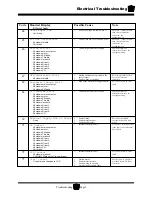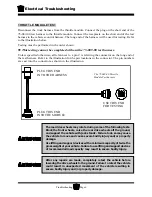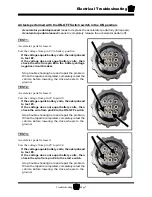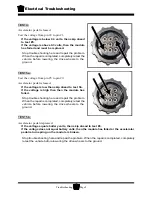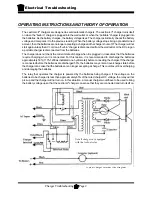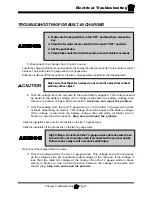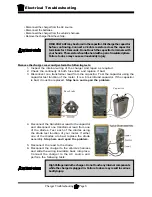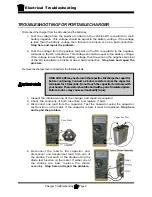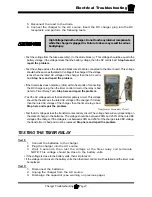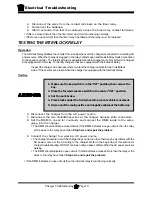
Electrical Troubleshooting
Charger Troubleshooting
Page 9
5. Reconnect the lead to the diode.
6. Connect the charger to the AC source. Insert the DC charger plug into the DC
receptacle and perform the following tests:
• Test the voltage from the fuse assembly (-) to the diode block (+). This voltage should be equal to the
battery voltage. If the voltage is less than the battery voltage, then the DC cord is bad.
Stop here and
repair the problem.
• Test the voltage across the white and black wires that are connected to the timer board. This voltage
should be the same as the rated AC voltage of the charger. If the voltage
is less than the rated AC voltage of the charger then the AC cord is
bad.
Stop here and repair the problem
.
• If the timer relay does not pickup (click) within 5 seconds of connecting
the DC charger plug, then the timer control circuit or the relay is bad
(refer to Timer Relay Test).
Stop here and repair the problem.
• Test the AC voltage across the transformer primary circuit. This voltage
should be the same as the rated AC voltage of the charger. If it is less
than the rated AC voltage of the charger, then the timer relay is bad.
Stop here and repair the problem.
• Test the AC voltage across the transformer secondary circuit. The voltage here will vary depending on
the state of charge in the batteries. The voltage should be between 208% and 250% of the rated DC
voltage of the charger. If the voltage is not between 208% and 250% of the charge’s rated DC voltage,
the transformer is bad and must be replaced.
Stop here and repair the problem.
Transformer Secondary Circuit
TESTING THE TIMER RELAY
Test 1:
1. Connect the batteries to the charger.
2. Plug the charger into the AC source.
3. Wait 5 seconds, then test the voltage at the timer relay coil terminals.
NOTE: This voltage should be close to the battery volts.
•
If the voltage is close to the battery volts, then skip to test 2.
•
If the voltage is not close to the battery volts, then the timer control circuit has failed and the timer must
be replaced.
Test 2:
1. Disconnect the batteries.
2. Unplug the charger from the AC source.
3. Discharge the capacitor (see warning on previous page).
High Voltage inside the charger. Do not touch any internal components
while the charger is plugged in. Failure to do so may result in serious
bodily injury.
Summary of Contents for B0-T48-48 Taylor Truck T48
Page 2: ......
Page 14: ...TAYLOR DUNN...
Page 30: ...TAYLOR DUNN...
Page 68: ...Maintenance Service and Repair Steering Page 22 Exploded View of Steering Gear...
Page 86: ...TAYLOR DUNN...
Page 112: ...TAYLOR DUNN...
Page 118: ...TAYLOR DUNN...
Page 130: ...TAYLOR DUNN...
Page 140: ...TAYLOR DUNN...
Page 152: ...Illustrated Parts Parts Page 2 Front Axle...
Page 154: ...Illustrated Parts Parts Page 4 Steering Knuckle...
Page 156: ...Illustrated Parts Parts Page 6 Steering Linkage...
Page 162: ...Illustrated Parts Parts Page 12 Rear Suspension View from rear...
Page 164: ...Illustrated Parts Parts Page 14 Transmission Gear Case...
Page 168: ...Illustrated Parts Parts Page 18 Rear Brakes Front Brakes...
Page 170: ...Illustrated Parts Parts Page 20 Brake Lines and Master Cylinder...
Page 172: ...Illustrated Parts Parts Page 22 Motor...
Page 174: ...Illustrated Parts Parts Page 24 Motor Mount Apply 94 421 34 grease to inside of motor coupler...
Page 186: ...Illustrated Parts Parts Page 36 Batteries FRONT OF VEHICLE...
Page 188: ...TAYLOR DUNN...

